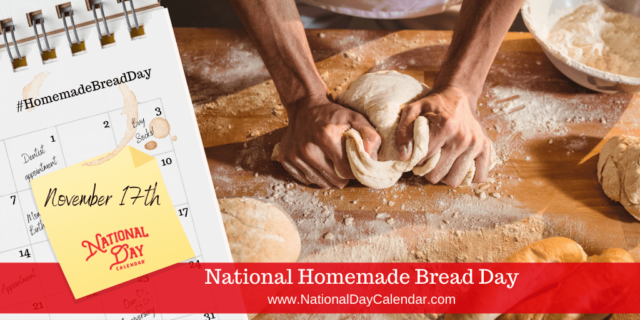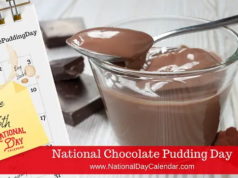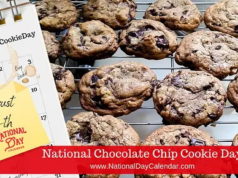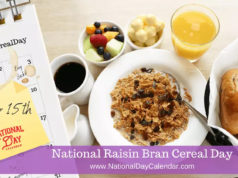
On November 17, homes will fill with warm, comforting aromas reminding us to slow down and enjoy National Homemade Bread Day.
- It takes 9 seconds for a combine to harvest enough wheat to make about 70 loaves of bread.
- Each American consumes, on average, 53 pounds of bread per year.
- An average slice of packaged bread contains only 1 gram of fat and 75 to 80 calories.
- Bread is closely tied to religious expression and communion. Hot cross buns commemorate Lent and Good Friday, Greek Easter breads are set with eggs dyed red to denote the blood of Christ, and Jewish families celebrate the coming of the Sabbath on Friday evening with challah.
- In 1997, Kansas wheat farmers produced enough wheat to make 36.5 billion loaves of bread, or enough to provide each person on earth with 6 loaves of bread.
- Napoleon gave a common bread its name when he demanded a loaf of dark rye bread for his horse during the Prussian campaign. “Pain pour Nicole,” he ordered, which meant “Bread for Nicole,” his horse. To Germanic ears, the request sounded like “pumpernickel,” which is the term we use today for this traditional loaf.
- In Britain, the ceremony of First Footing is traditionally observed in the early hours of New Year’s Day. A piece of bread is left outside a door, with a piece of coal and a silver coin, and is supposed to bring you food, warmth and riches in the year ahead.
- The fastest “bun” in the West goes to a team of bakers from Wheat Montana Farms and Bakery who reclaimed the Guinness World Record in 1995. They harvested and milled wheat from the field and then mixed, scaled, shaped and baked a loaf in exactly eight minutes, 13 seconds.
- Scandinavian traditions hold that if a boy and girl eat from the same loaf, they are bound to fall in love.
- In Russia, bread (and salt) are symbols of welcome.
- Superstition says it is bad luck to turn a loaf of bread upside down or cut an unbaked loaf.
- Legend has it that whoever eats the last piece of bread has to kiss the cook.
- Sliced bread was only invented in 1928 and was referred to as the best thing since bagged bread. – Source
- The distinction of “upper crust” comes from the 1600s. When the bread was made in stone ovens the bottoms would become dirty from ash and soot. If you were wealthy you cut the bottom crust off and just ate the “upper crust” part of the bread. – Source
- Ancient Egyptians used moldy bread as a treatment for infected burn wounds, possibly already utilizing the antibiotic effects of molds accidentally discovered by Alexander Fleming. – Source
- Before the Eraser was invented people used soft bread crumbs to erase pencil marks. – Source
- In France, by law a bakery has to make all the bread it sells from scratch in order to have the right to be called a bakery. – Source
- Nearly all the bread clips, those flat, U-shaped pieces of plastic are produced by one family-owned company in Yakima, Washington. The first one was carved from a credit card, the company exports billions a year, and the Kwik Lok Corporation has an almost complete monopoly. – Source
- A nearly 2,000-year-old loaf of bread was found during excavations in Herculaneum, and the recipe has been recreated by The British Museum. – Source
- Ciabatta is not a traditional Italian bread, it was invented in the 80s as a response to the popularity of baguettes. – Source
- Bread become sweeter the longer you chew as your saliva starts to break down starch into sugars. – Source
- When the buttered bread is right side up and dropped from a table, there’s an ~80% it will fall butter side down. This is because an average slice of buttered bread falling will complete a full turn in approx. 8 feet. – Source
- The ancient Greeks were already producing more than 80 types of bread in 2500 B.C.
- Bread was so important to the Egyptian way of life that it was used as a type of currency. They revered it so much they would often place it in the tombs of their dead.
- Bakers used to be fined if their loaves were underweight so they added an extra loaf to every dozen, hence the term “Baker’s Dozen.”
- Bread, in all its various forms, is the most widely consumed food in the world.
- Bread appears 360 times in the Bible (KJV). 280 times in the Old Testament and 80 times in the New Testament.
- While bread has been used since the the 17th century to clean the frescoes on the ceiling of the Sistine Chapel, restorationists have found that Wonder Bread, and it’s sponge texture, it a remarkably efficient tool cleaning the Michelangelo’s “Creation of Adam.”
Sources:












